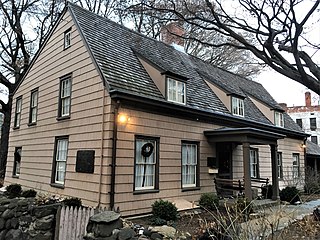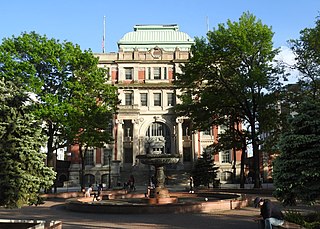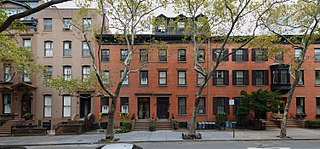
Jamaica is a neighborhood in the New York City borough of Queens. It is mainly composed of a large commercial and retail area, though part of the neighborhood is also residential. Jamaica is bordered by Hollis to the east; St. Albans, Springfield Gardens, Rochdale Village to the southeast; South Jamaica to the south; Richmond Hill and South Ozone Park to the west; Briarwood to the northwest; and Kew Gardens Hills, Jamaica Hills, and Jamaica Estates to the north.

The John Bowne House is a house in Flushing, Queens, New York City, that is known for its role in establishing religious tolerance in the United States.

The Long Island City Courthouse is located at 25-10 Court Square in Long Island City, Queens, New York City. It formerly housed Criminal Court, County Court, the District Attorney staff, and the county sheriff's office. Today the Courthouse is another home to the Civil Term of Supreme Court, Queens County, which also sits in Jamaica. The courthouse was originally built in 1874 to a design by architect George Hathorne, and was remodeled and enlarged by Peter M. Coco in 1904. It was considered to be one of the most important buildings in Queens County.

King Manor, also known as the Rufus King House, is a historic house at 150th Street and Jamaica Avenue in Jamaica, Queens, New York City. It was the home of Founding Father Rufus King, a signatory of the United States Constitution, New York state senator, and ambassador to Great Britain immediately after the American Revolution. Descendants of King's family lived in the house until 1896 when Rufus' granddaughter Cornelia King died and the house was sold to the Village of Jamaica. When the western half of Queens, including Jamaica, became part of the City of Greater New York, the house and the property were turned over to the New York City Parks Department which redesignated the land as Rufus King Park.

The Brooklyn Heights Historic District is a historic district that comprises much of the Brooklyn Heights neighborhood of Brooklyn, New York City. It was named a National Historic Landmark in January, 1965, designated a New York City Landmark in November, 1965, and added to the National Register of Historic Places in October, 1966.

The Scribner Building is a commercial structure at 155 Fifth Avenue, near 21st Street, in the Flatiron District of Manhattan in New York City. Designed by Ernest Flagg in the Beaux Arts style, it was completed in 1893 as the corporate headquarters of Charles Scribner's Sons publishing company.

The First Reformed Church is a historic Reformed church in the Jamaica neighborhood of the New York City borough of Queens. The church was built in 1859. The church has an early romanesque structure that was designed by Sidney J. Young and built by Anders Peterson. The First Reformed Church has been refurbished as part of the Jamaica Center for Arts & Learning.

The Flatbush Reformed Protestant Dutch Church, also known as the Flatbush Reformed Church, is a historic Dutch Reformed church – now a member of the Reformed Church in America – at 890 Flatbush Avenue in the Flatbush neighborhood of Brooklyn, New York City. The church complex consists of the church, cemetery, parsonage and church house.

Grace Episcopal Church Complex is a historic Episcopal church complex at 155-15 Jamaica Avenue in Jamaica, Queens, New York City, in U.S. state of New York. The complex includes the church, parish house, and cemetery. The church was built between 1861 and 1862. It is constructed of rough-cut sandstone and features a steeply pitched roof and tall, sharp spire in the Gothic Revival style. A chancel, designed by Cady, Berg & See, was added at the rear of the church in 1901-1902. The parish house, known as Grace Memorial House, was built in 1912. It is three-story brick building in the Tudor Revival style. The surrounding cemetery includes burials dating to 1734, when the church located at this site. Notable interments include Rufus King (1755–1827), Charles King (1789–1867) and William Duer (1743–1799).

George Willard Conable (1866-1933), AIA, was an American architect practicing in New York City in the early to mid 20th century specializing in churches.

The Jamaica Savings Bank was a bank incorporated in 1866 in the Jamaica section of the borough of Queens in New York City. It had four branches across Queens before it was acquired by North Fork Bank in 1999, which itself was acquired by Capital One Bank in 2008.

Jamaica Chamber of Commerce Building is a historic office building located in the Jamaica section of the New York City borough of Queens. It was designed in 1928 by George W. Conable (1866-1933) and is a ten-story, "T" shaped building in the Colonial Revival style.

La Casina is a historic commercial building located in Jamaica, Queens. New York City. It was originally built about 1907 and completely redesigned about 1936 in the Streamline Moderne style. It is a one-story building designed for use as a nightclub. It has a streamlined facade in the form of a stepped pyramid or ziggurat. The building retains its original vertical neon sign. From the 1940s through 1987, the building housed a clothing factory.

The sidewalk clock on Jamaica Avenue is an early-20th-century sidewalk clock at the southwest corner of Jamaica Avenue and Union Hall Street in the Jamaica neighborhood of Queens in New York City. The cast iron clock's design incorporates a bell-cast shaped column base and an anthemion finial above the dial casing.

Prospect Cemetery is a historic cemetery located in the Jamaica section of the New York City borough of Queens. It was established in 1668 and known as the "burring plas." The cemetery's original main gate was on Beaver Road which led from Sutphin Boulevard to Jamaica Avenue. The cemetery was generally known as the Presbyterian burial ground and is one of the few remaining Colonial cemeteries in Queens.

The Steinway Mansion is at 18-33 41st Street on a one-acre hilltop in the Astoria neighborhood of Queens in New York City. It was built in 1858, originally on 440 acres (1.8 km2) on the Long Island Sound, by Benjamin Pike Jr., a manufacturer of scientific instruments.

The Jamaica Center for Arts & Learning in Jamaica, Queens, New York is a performing and visual arts center that was founded in 1972 in an effort to revitalize the surrounding business district. As of 2012, it serves more than 28,000 people annually via a 1,650 square foot gallery, a 99-seat proscenium theater, and art & music studios. The building that houses the center is the former Queens Register of Titles and Deeds Building, a New York City landmark that is also listed on the National Register of Historic Places. Outside the building is one of only two remaining cast-iron sidewalk clocks in New York City, as well as a late-Victorian era headquarters of the Jamaica Savings Bank next door.

The Jamaica Savings Bank is a building at Jamaica Avenue and Sutphin Boulevard in Jamaica, Queens, New York City. The building was built between 1938 and 1939 in the Art Deco style. It replaced the Queensboro Savings Bank at 90-55 Sutphin Boulevard, which was acquired by the Jamaica Savings Bank in 1934 and demolished in 1938. The address was changed to the current 146-21 Jamaica Avenue and is a New York City designated landmark.
Richmond Hill Historic District is a national historic district in Richmond Hill, Queens, New York. It is bounded to the north by Park Lane South, to the east by 118th Street, to the south by Myrtle Avenue. The district includes 200 contributing buildings built between 1890 and 1915 next to the former South Side Railroad line and the Richmond Hill station at Hillside Avenue, shaped roughly like a triangle. They consist mainly of architectural styles dating back to an earlier time of Academic Eclecticism in home building and were constructed for railroad commuters. Most of the contributing properties were planned as suburbs to Brooklyn and Manhattan. It also included smaller houses built between 1917 and 1930 at the beginning of the Great Depression.























